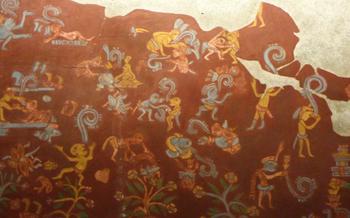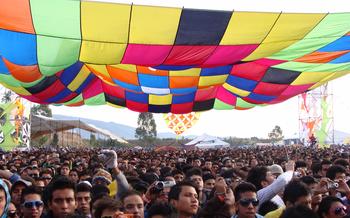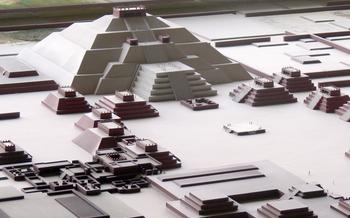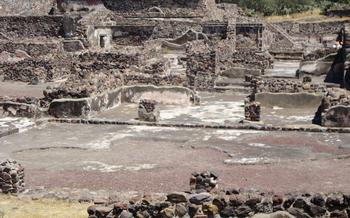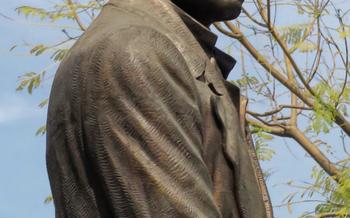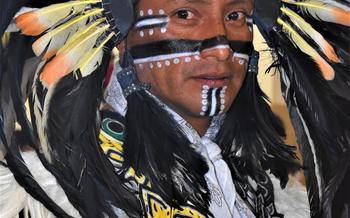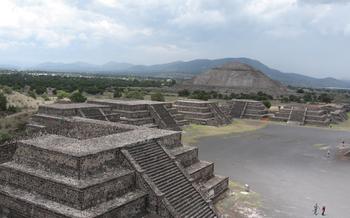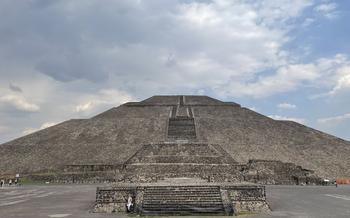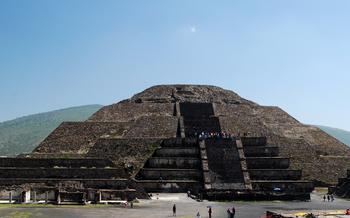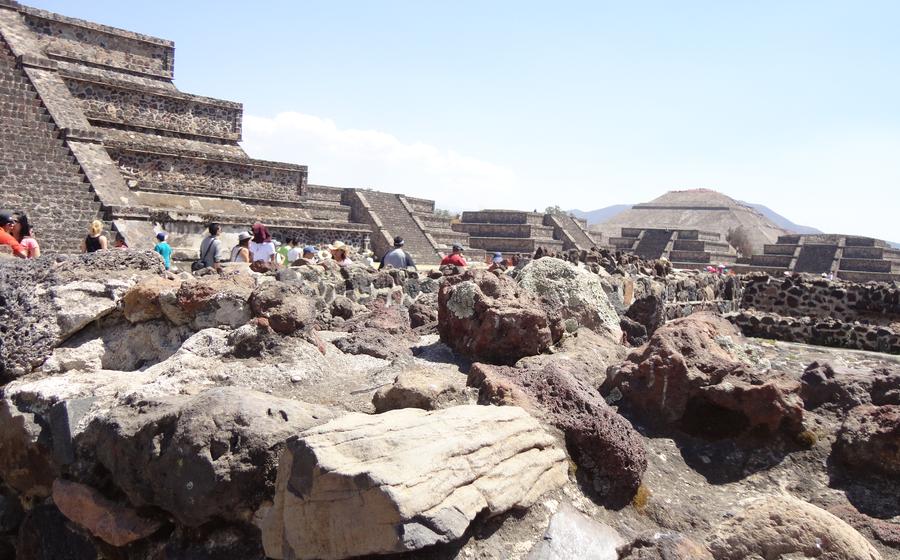
Chapultepec Park
- Teotihuacan, a journey through history
- The Pyramids of the Sun and the Moon
- The Avenue of the Dead
- The Ciudadela: A Center of Power and Ritual
- The Palace of Quetzalpapalotl
- The Teotihuacan Museum: A Journey Through Time
- The Hot Air Balloon Experience
- The Night Show
- The Surroundings of Teotihuacan
- The Local Cuisine
- The Handicrafts
- The Festivals
- The Accommodation
- Insider Tip:
Teotihuacan, a journey through history
Teotihuacan, located just 50 kilometers northeast of Mexico City, is an ancient Mesoamerican city that flourished between the 1st and 7th centuries AD. It is one of the most important archaeological sites in the Americas and a UNESCO World Heritage Site. The city's name means "Place of the Gods" in Nahuatl, the language of the Aztecs, who arrived in the area long after Teotihuacan was abandoned.
The construction of Teotihuacan is shrouded in mystery. It is believed that the city was founded by a group of nomadic people who settled in the Valley of Mexico around 100 BC. Over time, Teotihuacan became a major religious, political, and economic center, with a population of over 100,000 people. The city's influence extended throughout Mesoamerica, and its culture and architecture had a profound impact on other civilizations in the region.
The most iconic structures in Teotihuacan are the Pyramids of the Sun and the Moon, which dominate the city's skyline. The Pyramid of the Sun is the largest pyramid in Mesoamerica, with a height of 65 meters and a base of 225 meters. The Pyramid of the Moon is slightly smaller, with a height of 45 meters and a base of 150 meters. Both pyramids are believed to have been built for religious purposes, and they were likely used for human sacrifices and other rituals.
Teotihuacan was a well-planned city, with a grid system of streets and a central avenue, known as the Avenue of the Dead, which ran north-south for over 2 kilometers. The city was also home to a number of temples, palaces, and residential compounds. The Teotihuacan people were skilled artisans, and they produced a wide range of ceramics, textiles, and other goods. They were also accomplished traders, and their goods were found throughout Mesoamerica.
Teotihuacan's decline began around the 7th century AD, and the city was eventually abandoned by its inhabitants. The reasons for the city's collapse are not fully understood, but it is believed that a combination of factors, including climate change, political instability, and warfare, may have contributed to its demise.
Teotihuacan is a fascinating and awe-inspiring place, and it is a must-see for anyone interested in ancient history and culture. The city's ruins are a testament to the ingenuity and creativity of the Teotihuacan people, and they offer a glimpse into a world that is long gone.
The Pyramids of the Sun and the Moon
The Pyramids of the Sun and the Moon are the most iconic landmarks of Teotihuacan. The Pyramid of the Sun is the third-largest pyramid in the world, standing at an impressive 75 meters (246 feet) tall. It was built in the 1st century AD using millions of adobe bricks, without the use of wheels or metal tools. The Pyramid of the Moon, located at the northern end of the Avenue of the Dead, is slightly smaller but still stands at an impressive 45 meters (148 feet) tall. Both pyramids have a square base and four sides with steep steps leading to the top. The pyramids were faced with white stucco, which has since eroded away.
Architectural Characteristics and Materials
The Pyramids of the Sun and the Moon showcase remarkable architectural achievements. They were built using a combination of adobe bricks, stone, and mortar. The adobe bricks were made from a mixture of clay, sand, and straw, and were dried in the sun. Stone was used for the facing of the pyramids and for the construction of the stairs and ramps. The pyramids were built on a massive platform, which helped to distribute their weight and prevent them from sinking into the soft ground. The platforms were also used to create a level surface for the construction of the pyramids.
Religious Significance
The Pyramids of the Sun and the Moon were built as temples for religious purposes. The Pyramid of the Sun was dedicated to the sun god, while the Pyramid of the Moon was dedicated to the moon goddess. The pyramids were used for various religious rituals and ceremonies, including offerings, sacrifices, and prayers. The layout of the pyramids and their alignment with the cardinal points suggest that they were also used for astronomical observations. The pyramids were built in such a way that they would align with the sun during the equinoxes and solstices, which were important religious events in the Teotihuacan culture.
Views from the Top
Climbing to the top of the Pyramids of the Sun and the Moon is a must-do experience for visitors to Teotihuacan. The views from the top are breathtaking and offer a unique perspective of the city's layout. From the top of the Pyramid of the Sun, visitors can see the entire Avenue of the Dead, the Temple of Quetzalcoatl, and the surrounding mountains. The views from the top of the Pyramid of the Moon are equally impressive, offering a closer look at the Temple of Quetzalcoatl and the Ciudadela.
The Avenue of the Dead
The Avenue of the Dead is the main road that crosses Teotihuacan from north to south. It is a wide, straight avenue flanked by buildings, platforms, and temples. It begins at the Ciudadela, in front of the Pyramid of the Sun, and ends at the Temple of Quetzalcoatl, located at the southern end of the city.
The Avenue of the Dead is not just a road but a sacred space. It was aligned with the astronomical events, and the cardinal points were of great importance to the Teotihuacan people. The avenue was used for religious processions, ceremonies, and rituals. It was also a place where people gathered, traded, and exchanged ideas.
Walking along the Avenue of the Dead is a magical experience. It is like stepping back in time and feeling the presence of the ancient Teotihuacan people. The avenue is surrounded by impressive buildings and structures, and the atmosphere is solemn and awe-inspiring.
One of the highlights of the Avenue of the Dead is the view from the top of the Pyramid of the Sun. From there, visitors can appreciate the layout of the city, with the Avenue of the Dead as its central axis. The view is breathtaking and offers a unique perspective on this ancient city.
The Ciudadela: A Center of Power and Ritual
Located north of the Pyramid of the Sun, the Ciudadela is a large plaza that served as an administrative and ceremonial center for the ancient Teotihuacanos. Surrounded by a massive wall, it was a sacred space where important rituals and ceremonies were held.
The Ciudadela is dominated by the Temple of Quetzalcoatl, located at the far end of the plaza. This impressive temple is dedicated to the feathered serpent god, Quetzalcoatl, one of the most important deities in Mesoamerican mythology. The temple features unique architectural elements, such as feathered serpent heads and the talud-tablero style, which consists of alternating sloping panels and vertical boards.
Besides the Temple of Quetzalcoatl, the Ciudadela is surrounded by other significant buildings and structures. These include the Temple of the Feathered Shells, the Temple of the Jaguar Warriors, and several residential and administrative buildings. The Ciudadela was a bustling center of activity, where religious ceremonies, political meetings, and trade took place.
Stepping into the Ciudadela, visitors are transported back in time, surrounded by the grandeur of ancient Teotihuacan. The massive walls, the towering temple, and the intricate carvings create an atmosphere of awe and wonder, evoking the power and influence of the Teotihuacan civilization.
The Palace of Quetzalpapalotl
On the east side of the Ciudadela, visitors can explore the Palace of Quetzalpapalotl, a remarkable example of Teotihuacan's architectural prowess. This grand palace served as a residential and administrative center for the city's elite, housing high-ranking officials and their families. The palace's intricate murals and paintings offer a glimpse into the daily life and mythology of the Teotihuacan people, depicting scenes of feasting, dancing, and religious ceremonies. These vibrant murals, adorned with vibrant colors and intricate details, provide a vivid narrative of the city's rich cultural heritage.
The Palace of Quetzalpapalotl stands as a testament to the power and wealth of the Teotihuacan civilization. Its impressive size and elaborate decorations showcase the ingenuity and artistry of its builders. Visitors can wander through the palace's numerous rooms and courtyards, admiring the well-preserved murals and imagining the lives of the people who once inhabited this grand residence. The Palace of Quetzalpapalotl is a must-see for anyone interested in exploring the grandeur and complexity of Teotihuacan's ancient society.
The Teotihuacan Museum: A Journey Through Time
Located at the entrance of the archaeological site, the Teotihuacan Museum is a treasure trove of artifacts and objects that provide a glimpse into the history, culture, and lifestyle of the Teotihuacan people. The museum's collection includes an impressive array of sculptures, ceramics, jewelry, and other relics that have been carefully excavated from the ruins of the ancient city.
Through interactive exhibits and informative displays, the museum takes visitors on a journey through time, shedding light on the origins, development, and eventual decline of the Teotihuacan civilization. Visitors can learn about the city's complex political and social structure, its religious beliefs and practices, and its remarkable achievements in art, architecture, and engineering.
One of the highlights of the museum is the collection of large-scale sculptures, including the iconic head of Quetzalcoatl, the feathered serpent god. These impressive works of art provide a glimpse into the artistic prowess and religious devotion of the Teotihuacan people. The museum also houses a collection of ceramics that showcase the intricate craftsmanship and decorative techniques employed by the ancient artisans.
A visit to the Teotihuacan Museum is an essential complement to exploring the archaeological site. It offers visitors the opportunity to gain a deeper understanding of the significance of Teotihuacan and to appreciate the enduring legacy of this remarkable civilization.
The Hot Air Balloon Experience
For an unforgettable perspective of Teotihuacan, take a hot air balloon ride over the ancient city. As you float gently above the pyramids, the Avenue of the Dead, and the surrounding landscape, you'll be in awe of the sheer scale and grandeur of this ancient metropolis. The views are breathtaking, and the feeling of floating over these iconic ruins is truly magical.
Hot air balloon rides typically last for about an hour, and they offer a unique opportunity to see Teotihuacan from a completely different angle. You'll be able to appreciate the layout of the city, the symmetry of the pyramids, and the vastness of the archaeological site. It's an experience that you won't soon forget.
Prices for hot air balloon rides start at around $100 per person, and they can be booked online or through local tour operators. Rides are typically offered at sunrise and sunset, when the light is at its most beautiful. If you're looking for a truly special and memorable experience, a hot air balloon ride over Teotihuacan is an absolute must.
The Night Show
Teotihuacan's night show is an unforgettable experience that takes visitors on a journey through the history and culture of this ancient city. Held on select nights throughout the year, the show uses lights, sound, and projections to create a magical atmosphere that brings the pyramids to life.
As darkness falls, the pyramids of the Sun and the Moon become a canvas for a spectacular light show. The projections tell stories of the Teotihuacan people, their beliefs, and their way of life. The sound of traditional music and the voices of narrators fill the air, creating a truly immersive experience.
The night show is a unique opportunity to see the pyramids in a new light and to learn about Teotihuacan's rich history. It is a must-see for anyone interested in Mexican culture and history.
Practical information:
- The night show is held on select nights throughout the year. Check the official website for dates and times.
- Tickets can be purchased online or at the entrance to the archaeological site.
- The show lasts for about an hour.
- Visitors are advised to bring warm clothing, as it can get chilly at night.
The Surroundings of Teotihuacan
The city of Teotihuacan is surrounded by a wealth of attractions that are worth exploring. Visitors can take a day trip to the nearby town of Tenayuca to visit the impressive Pyramid of Tenayuca, which is one of the oldest and best-preserved pyramids in Mexico. Another popular destination is the Basilica of Guadalupe, located just a short distance from Teotihuacan. This beautiful church is one of the most important pilgrimage sites in the world and is dedicated to the Virgin of Guadalupe, the patron saint of Mexico.
For a unique and unforgettable experience, visitors can take a boat tour through the Floating Gardens of Xochimilco, a series of canals and islands located just south of Mexico City. These gardens are a UNESCO World Heritage Site and offer a glimpse into the traditional way of life in this region.
The surroundings of Teotihuacan are also home to several charming towns and villages, each with its unique character and attractions. Visitors can explore the colorful markets, sample the delicious local cuisine, and learn about the rich history and culture of this region.
Practical information:
- To visit the Pyramid of Tenayuca, take a bus from the Teotihuacan bus station to the town of Tenayuca. The pyramid is located a short walk from the bus stop.
- The Basilica of Guadalupe can be reached by taking the metro to the Basilica de Guadalupe station. The church is located a short walk from the station.
- To visit the Floating Gardens of Xochimilco, take the metro to the Xochimilco station. From there, you can take a boat tour from one of the many piers along the canal.
- There are several tour operators that offer day trips to the surroundings of Teotihuacan. These tours typically include transportation, a guide, and entrance fees to the attractions.
The Local Cuisine
The gastronomy of Teotihuacan is a unique blend of pre-Columbian and modern flavors that has been passed down from generation to generation. The region's traditional dishes are prepared using fresh local ingredients and often feature centuries-old recipes.
One of the most iconic dishes of Teotihuacan is barbacoa, a slow-cooked meat dish that is typically made with lamb or goat. The meat is seasoned with a variety of spices and herbs, then wrapped in maguey leaves and cooked in a pit in the ground. The result is a tender and flavorful dish that is often served with tortillas, salsa, and guacamole.
Another local specialty is pulque, a fermented beverage made from the sap of the maguey plant. Pulque has a slightly sour and milky taste and is often flavored with fruits or spices. It is a popular drink in Teotihuacan and is often served at festivals and celebrations.
Nopales, or prickly pear cactus, is another common ingredient in Teotihuacan cuisine. Nopales can be eaten raw, cooked, or dried and ground into a powder. They are often used in salads, soups, and stews, and can also be used to make a variety of sauces and relishes.
Visitors to Teotihuacan can sample the local cuisine at a variety of restaurants and markets. The Mercado de Artesanías y Comida is a great place to find traditional dishes and souvenirs, while the Restaurante La Gruta offers a more upscale dining experience with a focus on regional cuisine.
The Handicrafts
In the vibrant markets and workshops of Teotihuacan, the spirit of creativity and tradition thrives. Artisans, skilled in the art of crafting unique and authentic items, showcase their talents through exquisite handicrafts. These treasures, meticulously crafted using local materials and techniques, embody the rich cultural heritage of the region.
From intricately woven textiles and colorful pottery to hand-carved wooden figurines and gleaming obsidian jewelry, each piece tells a story, capturing the essence of Teotihuacan's past and present. Visitors can witness the artisans at work, marveling at their skill and patience as they transform simple materials into works of art.
In the bustling market stalls, vibrant textiles, adorned with traditional patterns and vibrant hues, catch the eye. Shoppers can find everything from intricately embroidered blouses and skirts to colorful shawls and tablecloths, each piece a testament to the region's textile artistry.
Ceramic workshops, scattered throughout the town, showcase a dazzling array of pottery, from hand-painted plates and bowls to decorative vases and figurines. Each piece is unique, boasting intricate designs and vibrant colors inspired by ancient Teotihuacan motifs.
For those seeking one-of-a-kind souvenirs, the obsidian workshops offer a fascinating glimpse into the ancient craft of stone carving. Artisans skillfully shape obsidian, a volcanic glass, into delicate jewelry, sculptures, and decorative pieces, showcasing their mastery of this challenging material.
Teotihuacan's handicrafts are not just souvenirs; they are tangible pieces of history and culture. By purchasing these items, visitors not only support local artisans but also contribute to preserving and promoting the rich traditions of this ancient city.
The Festivals
Teotihuacan is not only a place of ancient ruins and historical significance but also a vibrant center of culture and tradition. Throughout the year, the city hosts a variety of festivals and celebrations that offer visitors a chance to experience the local culture firsthand.
One of the most important festivals is the Feast of Our Lady of Guadalupe, held on December 12th. This religious festival honors the patron saint of Mexico and attracts millions of pilgrims from all over the country. The celebrations include processions, masses, and traditional dances, culminating in a colorful fireworks display at the Basilica of Guadalupe.
Another popular festival is the Teotihuacan Cultural Festival, held in March or April. This festival showcases the rich cultural heritage of the region through music, dance, theater, and art exhibitions. Visitors can enjoy traditional performances, sample local cuisine, and participate in workshops on traditional crafts and customs.
During the Day of the Dead celebrations in November, Teotihuacan transforms into a magical realm of colorful altars, offerings, and candlelight processions. The city's ancient pyramids and streets become a stage for honoring the deceased and celebrating the continuity of life.
These are just a few examples of the many festivals that take place in Teotihuacan throughout the year. By attending one of these events, visitors can immerse themselves in the local culture, experience the vibrant traditions, and create lasting memories of their time in this ancient city.
The Accommodation
Teotihuacan offers a wide range of accommodation options to suit different budgets and preferences. Visitors can choose from hotels, hostels, guesthouses, and vacation rentals, all located within easy reach of the archaeological site.
For those seeking a luxurious and comfortable stay, several hotels offer modern amenities, spacious rooms, and stunning views of the pyramids. Mid-range hotels and guesthouses provide a good balance of comfort and affordability, with clean and well-equipped rooms at reasonable prices.
Budget travelers can opt for hostels, which offer dormitory-style accommodations and a chance to socialize with fellow travelers. Vacation rentals, such as apartments and houses, are also available for those seeking a more private and home-like experience.
To get the most out of your stay, it's advisable to book your accommodation in advance, especially if visiting during peak season. Online booking platforms and travel agents can assist with finding the best deals and availability.
Here are some specific accommodation recommendations:
- Hotel Quinta Real Zacatecas: A luxury hotel offering elegant rooms, a rooftop pool, and panoramic views of the pyramids.
- Hotel Casa de la Luna: A charming boutique hotel with beautifully decorated rooms and a peaceful ambiance.
- Hostel Celic: A popular hostel with a friendly atmosphere, comfortable common areas, and a variety of room options.
- Airbnb: A great option for finding unique and affordable vacation rentals in Teotihuacan.
Whether you're looking for a luxurious retreat, a budget-friendly option, or a home away from home, Teotihuacan has something to offer every traveler.
Insider Tip:
For an unforgettable experience, plan your visit to Teotihuacan during the spring or fall to avoid the extreme heat and crowds of the summer months. Also, consider arriving early in the morning to beat the midday sun and have the archaeological site practically to yourself. Wear comfortable shoes suitable for walking on uneven surfaces, as you'll be doing a lot of exploring on foot. Don't forget to bring plenty of water and snacks, as there are limited food and beverage options available within the site. To make the most of your visit, purchase a map and guidebook at the entrance to help you navigate the vast complex and learn about the history and significance of the different structures. If you have time, combine your visit to Teotihuacan with a trip to the nearby Pyramid of Tenayuca, an equally impressive pre-Columbian site located just a short distance away.
